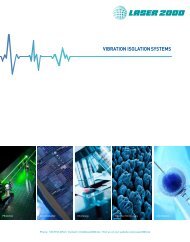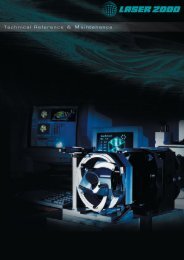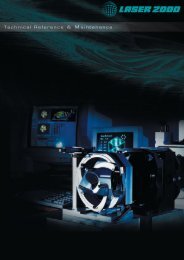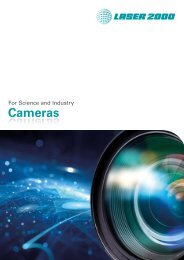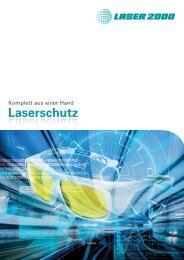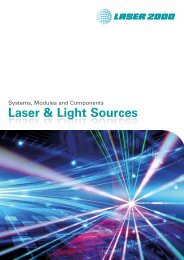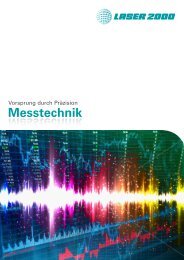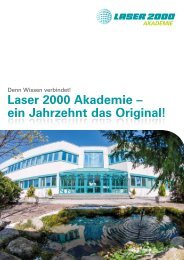Semrock Master Catalog 2018
Semrock Master Catalog 2018
Semrock Master Catalog 2018
Create successful ePaper yourself
Turn your PDF publications into a flip-book with our unique Google optimized e-Paper software.
BrightLine ® Fluorescence Filters<br />
Hard-coated Durability − The No Burn-out Promise<br />
Can be cleaned and handled, even with acetone<br />
Impervious to humidity, insensitive to temperature<br />
No soft coatings – no exceptions<br />
No Burn-out, No Periodic Replacement Needed<br />
Competitor<br />
Premium DAPI Exciter<br />
After < 300 hours<br />
Degraded!<br />
<strong>Semrock</strong><br />
DAPI Exciter<br />
After 1000 hours<br />
No Change!<br />
Stands up to intense xenon, mercury,<br />
metal halide, LED, and halogen light sources<br />
No adhesives in the optical path to darken,<br />
degrade, or autofluoresce<br />
Made with the same refractory materials as<br />
our high “laser damage threshold” laser optics<br />
Extremely dense, sputtered coatings do not<br />
absorb moisture and are insensitive to temperature<br />
Tests were performed to illustrate the resistance to optical damage of <strong>Semrock</strong>’s hard-coated filters as compared to that of a<br />
leading competitor’s soft-coated and absorbing glass filters. Continous irradiation from a conventional xenon arc lamp was used<br />
for the testing.<br />
The graph on the bottom left shows how a leading competitor’s DAPI exciter filter can become severely burned out even after<br />
only one day of exposure to 8 W/cm² of total intensity – here the transmission has dropped by 42%. By contrast, the <strong>Semrock</strong><br />
DAPI exciter is unchanged. Exposure of these two filters was continued with 1 W/cm² of total intensity (closely simulating the intensity<br />
seen by an exciter near the arc lamp source in a typical fluorescence microscope). The photographs above show that the competitor’s<br />
DAPI exciter failed catastrophically after 300 hours – both the large crack and burn-out degradation go all the way through the filter.<br />
The <strong>Semrock</strong> filter is again unchanged even after more than 1000 hours of exposure.<br />
The graph at bottom right shows that a leading competitor’s soft-coated filters for visible wavelengths also show significant<br />
degradation after optical exposure, even at the intensity levels typical of most fluorescence microscopes. The transmission of<br />
these filters drops, and the spectra shift in wavelength. As always, the <strong>Semrock</strong> hard-coated filter shows no change.<br />
Transmission (%)<br />
100<br />
<strong>Semrock</strong><br />
90 DAPI<br />
Exciter<br />
80<br />
Before<br />
70<br />
After 1 day<br />
60<br />
50<br />
40<br />
30<br />
20<br />
10<br />
0<br />
320 330 340 350 360 370 380 390 400 410 420<br />
Wavelength (nm)<br />
Competitor<br />
DAPI<br />
Exciter<br />
Transmission (%)<br />
100<br />
90<br />
80<br />
70<br />
60<br />
50<br />
40<br />
30<br />
<strong>Semrock</strong><br />
FITC<br />
Exciter<br />
Competitor<br />
GFP<br />
Exciter<br />
Before<br />
After 5 days<br />
Competitor<br />
TexRed<br />
Exciter<br />
20<br />
10<br />
0<br />
425 450 475 500 525 550 575 600 625<br />
Wavelength (nm)<br />
Transmission spectra of DAPI exciters before (blue) and after (red)<br />
exposure to 8 W/cm 2<br />
(over 15 mm diameter) for 1 day.<br />
Transmission spectra of soft-coated exciters (for GFP and Texas Red)<br />
compared to a <strong>Semrock</strong> hard-coated exciter (for FITC) before (blue)<br />
and after (red) exposure to 1 W/cm² (over 25 mm diameter) for 5 days.<br />
8



